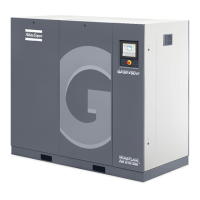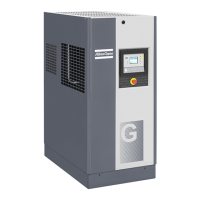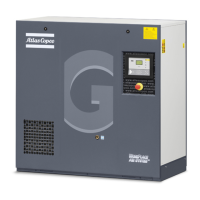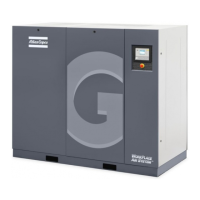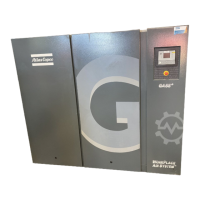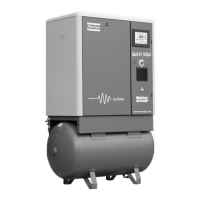Attention: It is only allowed to turn the wheel completely in or out. No in-between position is
allowed!
The oil cooler bypass valve (BV1) starts closing the bypass over the oil cooler (Co) at the lower limit of its
temperature range. At the upper limit of its temperature range, the bypass is completely closed and all the oil
flows through the oil cooler (Co).
BV1 must have a higher opening temperature (set point) than BV2 in order to prevent the heat from being
dissipated in the compressor oil cooler (Co) rather than in the oil/water heat exchanger (HE) when using the
compression heat as source for energy recovery.
Thermostat BV1 starts to open at 75 ˚C (167 ˚F) and is completely open at 90 ˚C (194 ˚F).
Energy recovery system in use (see drawing)
The wheel (V1) of BV2 (bypass valve of the HE) is totally turned in clockwise.
• Compressor start-up
When the compressor is started up from cold, the oil temperature will be low. Bypass valve (BV2) shuts off
the oil supply through the heat exchanger (HE) and bypass valve (BV1) shuts off the oil supply through the
oil cooler (Co) to prevent the compressor oil from being cooled. The oil flows from the oil separator vessel
(AR) through the oil filter(s) (OF) back to compressor element (E).
All energy input is used to rapidly warm up the compressor oil. No energy is recovered.
• Maximum energy recovery
As soon the oil temperature reaches the set point (opening temperature) of bypass valve (BV2), the valve
starts closing off the bypass over the heat exchanger (HE) oil line, gradually allowing the oil to flow through
the heat exchanger (HE). As the oil temperature rises to approx. 15 ˚C (27 ˚F) above the set point, all the oil
passes through the heat exchanger. The exchange of heat between the compressor oil and the heat recovery
water is maximum. The oil from the heat exchanger outlet flows via oil filter (OF), oil stop valve (Vs - if
present), compressor element (E) and separator (AR) back to the inlet of heat exchanger (HE). Bypass valve
(BV1) bypasses the oil cooler (Co) as long as the oil temperature remains below its set point.
Operation principle at different loads:
• Low consumption of recovered energy
The temperature of the oil leaving heat exchanger (HE) rises. When the temperature rises above its set
point, oil cooler bypass valve (BV1) will gradually allow the oil to be cooled in the oil cooler (Co).
• Recovery water flow too high/temperature too low
In this case, bypass valve (BV2) will open the bypass line allowing oil from heat exchanger (HE) to be
mixed with oil from separator (AR). Energy is transferred from the compressor oil to the water, but at a
relatively low temperature level.
Energy recovery system not in use
The wheel (V1) is completely turned out anti-clockwise.
The oil circuit is the same as without installation of the energy recovery system.
No energy is recovered.
This situation should be considered as exceptional, e.g. in case of maintenance of the energy recovery system
or when no energy is required for a long period.
On fixed speed compressors, run the unit unloaded for a few minutes before isolating the energy recovery
system from the compressor.
Instruction book
2920 7109 60 143
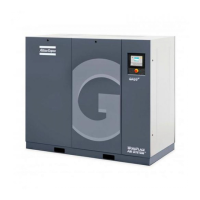
